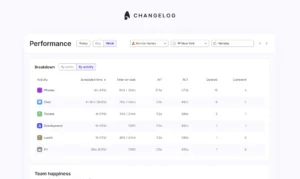
A guide for Average Handle Time (AHT) for email and chat

Understanding Average Handle Time (AHT) is a great way to start optimising your call centre performance, to balance operational efficiency with excellent customer service. This article explores what AHT is, why it’s important, how to measure it effectively — and how Surfboard’s advanced metrics can help your insights and planning.
What is AHT?
Average Handle Time (AHT) is a key performance metric used in call centres to measure the average duration it takes for agents to resolve a customer’s issue. For voice, it encompasses the total time spent handling a call, including:
- Talk time — the duration of the conversation between an agent and a customer.
- Hold time — the time during which a customer is placed on hold.
- After-call work (ACW) — the time spent by an agent completing tasks related to the call, such as entering information or following up.
For asynchronous channels, like email, chat or messaging, it encompasses the total time the conversation was open for, including:
- Reading and writing time — the time the agent spends reading the customer’s question or request and composing an answer.
- Research time — the time an agent may spend researching the answer or looking at CRM data
- Time spent waiting for a response — Unless removed, traditional AHT metrics will also time agent spent waiting for a response, which could be hours.
Most ticketing systems provide this data but it’s not useful for planning. Their metrics usually measure time from open to close, which inflates the number by including time spent waiting for a response.
To accurately estimate staffing required and plan your team efficiently, you need to know the amount of active working time agent’s spend on the ticket. For example, an email could have an AHT of 48 hours according to your ticketing system, but actually it only took 15 minutes of active agent time to read and write the responses, if you remove time spent waiting for a response.
Estimating using these calculations will drastically inflate your predicted CS expenditure and skew your budget. Additionally, while AHT is a critical metric for assessing operational efficiency, it’s essential to balance it with service quality. Aggressively pursuing lower AHT can lead to rushed interactions, potentially compromising customer satisfaction. The goal is to maintain a balance where AHT is minimised without sacrificing the quality of customer interactions.
Why is AHT important?
Impact on customer satisfaction
AHT directly translates to customer satisfaction. Long call durations can frustrate customers, especially if they feel their issues aren’t being resolved efficiently. However, an excessively short AHT might indicate that you aren’t addressing issues adequately. Balancing AHT with high-quality service is vital for maintaining customer satisfaction.
Operational cost implications
Reducing AHT can significantly impact your operational costs. Shorter handle times lead to more calls being managed within a given period, optimising labour costs and improving call centre throughput. However, you need to consider the trade-offs between cost efficiency and the quality of your customer support.
The balance between low AHT and high-quality service
While reducing Average Handle Time (AHT) can boost your operational efficiency, focusing solely on this metric may compromise service quality. A low AHT might indicate quicker call resolutions, but if agents are pressured to rush through interactions, it can lead to unresolved issues and increased customer frustration. Striking the right balance is crucial to ensure that efficiency does not come at the expense of thorough, high-quality customer service.
Besides AHT, click here to read about other metrics you can use to assess your call centre’s productivity.
How to measure AHT
Traditional measurement methods
Traditionally, AHT is measured using ticketing systems or call centre software, which track the time from when a call starts until it’s fully resolved. This method provides a straightforward calculation of average handle time.
Traditional methods can sometimes present inflated figures due to idle time or delays between messages. These limitations can obscure the true efficiency of your call centre operations.
Introduction to Surfboard’s metrics
Surfboard offers new, advanced metrics that provide a more nuanced view of call centre performance. These include:
- Average Interaction Time (AIT): This metric measures the average time spent on customer interactions, including talk time and hold time but excluding after-call work. AIT helps to assess the efficiency of interactions in real-time.
- Average Conversation Time (ACT): ACT focuses specifically on the average duration of conversations, excluding hold time and after-call work. This metric provides insights into the quality and efficiency of agent-customer interactions during the call itself.
Surfboard’s metrics offer several benefits over traditional AHT measurements:
- More accurate reflection of agent efficiency: AIT and ACT provide a clearer picture of interaction efficiency, helping to identify areas where improvements can be made.
- Enhanced insights for performance management: By separating conversation time from overall handle time, Surfboard enables more targeted coaching and training for agents.
- Improved customer experience: Accurate measurement of interaction times helps in optimising call flows and improving overall customer satisfaction.
Using AHT in workforce planning
AHT is crucial for workforce planning and forecasting. Accurate measurement allows call centres to predict staffing needs based on expected call volumes and handle times, ensuring optimal agent coverage.
With precise AHT data, call centres can better align staffing levels with call volume trends. This prevents overstaffing or understaffing and ensures that agents are available to handle calls efficiently without excessive wait times.
Surfboard’s metrics can help avoid overscheduling by providing detailed insights into interaction and conversation times. For example, if AIT or ACT shows an increase in call duration, it may indicate a need for additional staff or adjustments in scheduling to maintain service levels.
Benchmarking AHT
Benchmarking AHT against industry standards is essential for evaluating performance and identifying improvement opportunities. It helps in setting realistic targets and understanding how your call centre compares to others in the industry.
Surfboard provides anonymised customer data for benchmarking purposes, offering valuable insights into how your AHT compares to industry norms. With a diverse portfolio of customers ranging from e-commerce to financial technology solutions, Surfboard can give you a realistic, ambitious AHT target — and set you up for success. This data can be used to gauge performance and identify areas for potential improvement.
How benchmarking helps identify areas for improvement
By comparing your AHT with industry benchmarks, you can pinpoint discrepancies and address issues affecting performance. Benchmarking helps in setting achievable goals and implementing strategies to improve efficiency and customer satisfaction.
Summary
Average Handle Time (AHT) is a vital metric for call centres, reflecting the average duration of handling customer calls. Balancing AHT with service quality is crucial to ensure effective and satisfying customer interactions. Traditional measurement methods have limitations, but Surfboard’s advanced metrics, such as Average Interaction Time (AIT) and Average Conversation Time (ACT), provide a more accurate and insightful view of performance. Using these metrics can enhance workforce planning, prevent overstaffing, and facilitate effective benchmarking. By leveraging Surfboard’s data and metrics, call centres can optimise their operations and improve overall customer experience.
Book a demo to learn more about Surfboard’s innovative new metrics, or to get a demo of our full WFM solution.
FAQs
What is a good AHT for a call centre?
A good Average Handle Time (AHT) for a call centre typically hovers around six minutes, though this can vary based on the company’s approach to customer experience, the complexity of products or services, and the support channels used. AHT should be tailored to align with specific organisational goals while maintaining a balance between efficiency and service quality. Striving for a benchmark that supports both effective interactions and customer satisfaction is key.
What causes high AHT in call centres?
High AHT in call centres can be attributed to various factors, including a lack of agent knowledge, inefficient automation, technical issues, and the complexity of customer queries. Additionally, prolonged hold times and excessive after-call work can inflate AHT figures. Addressing these issues through improved training, better tools, and streamlined processes can help in managing and reducing AHT.
How can I reduce my team’s AHT?
To reduce your team’s AHT, focus on improving agent training to boost their efficiency and expertise. Implementing self-service options, automating repetitive tasks, and optimising support processes can also help. Additionally, using advanced metrics like Average Interaction Time (AIT) and Average Conversation Time (ACT) can provide a more accurate picture of performance and highlight areas for improvement.
How is AHT calculated?
Average Handle Time (AHT) is calculated by summing up the total talk time, hold time, and after-call work, then dividing this sum by the total number of calls handled. For calls, the formula is AHT = (talk time + hold time + after-call work) / total number of calls. This calculation helps gauge the average duration of customer interactions and is essential for assessing efficiency in a call centre.

